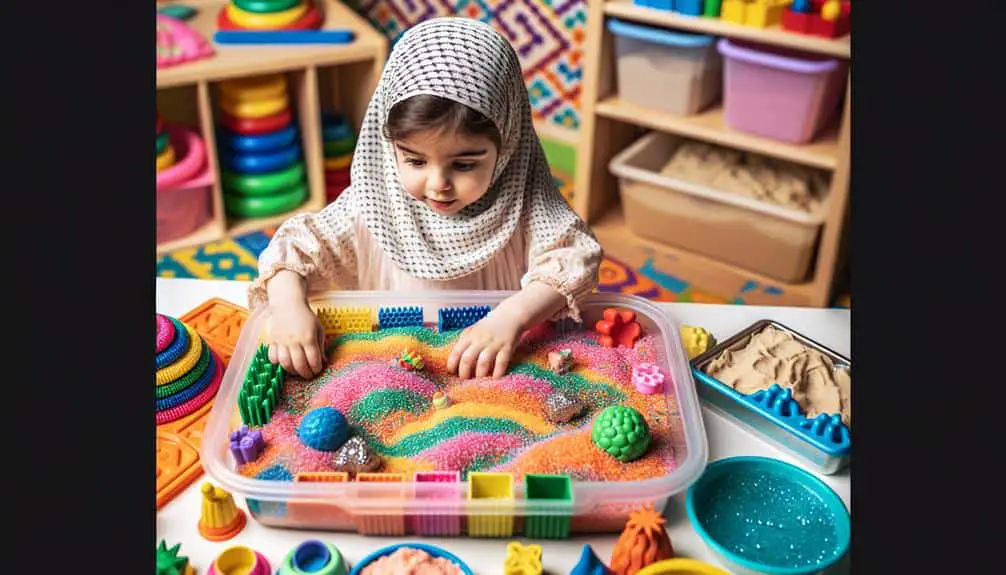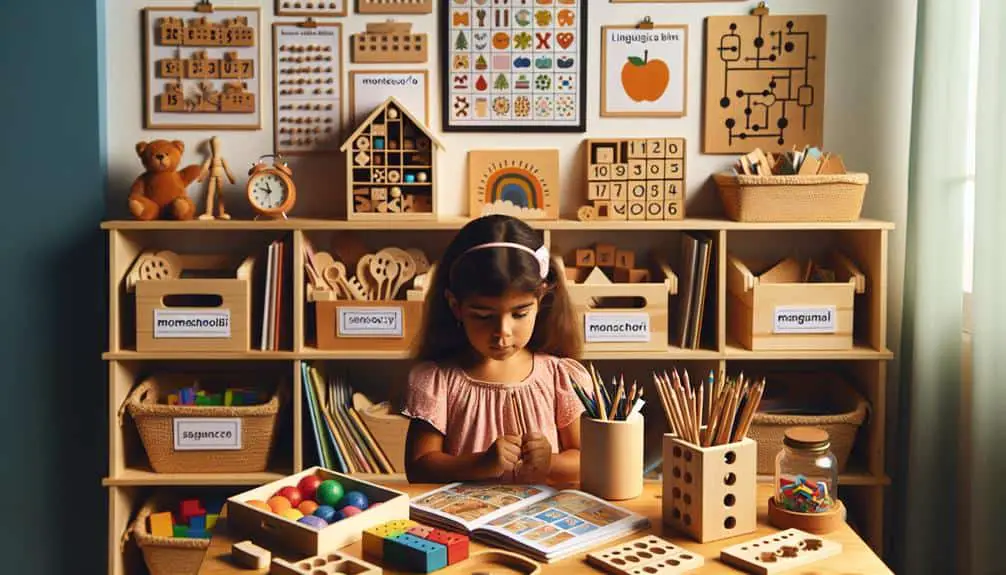Get hands-on with sensory play ideas for preschool homeschooling! Engage in DIY sensory bins for themed learning. Try mess-free sensory bottles or texture boards for tactile fun. Nature walks and sensory gardens offer outdoor exploration. Clay art projects and finger painting stimulate creativity. Engage all senses with sensory collages utilizing various textures. Use everyday items like food and water for educational play. Ready to spark imagination and learning through sensory activities? You're in for a treat with these interactive ideas that will engage your little one's senses and promote holistic development!
Key Points
- DIY sensory bins offer hands-on learning with various themes and fillers like colored rice, pasta, or small toys.
- Mess-free sensory activities include sensory bottles, texture boards, and sensory bags for tactile experiences without creating a mess.
- Nature-based sensory exploration through outdoor activities like nature walks, scavenger hunts, and sensory gardens fosters holistic development.
- Sensory art projects like clay art and finger painting enhance creativity, fine motor skills, and sensory stimulation.
- Incorporate everyday items like food, water, music, and natural elements into sensory play for educational experiences.
Benefits of Sensory Play
Explore how sensory play can ignite your child's imagination and enhance their cognitive development through hands-on experiences and interactive learning opportunities. By engaging in sensory activities, your little one not only hones their physical coordination but also improves their emotional regulation. Through play, kids learn to manage their feelings and reactions, an essential skill for maneuvering the complexities of life.
Moreover, sensory play fosters social interaction as children collaborate, share, and communicate while exploring different textures, smells, and sights. These interactions help them develop essential social skills like cooperation and empathy, setting a strong foundation for healthy relationships in the future.
Additionally, as your child manipulates various materials during sensory play, they're enhancing their cognitive development by refining problem-solving abilities and boosting creativity.
Embrace the joy of sensory play as a powerful tool for nurturing your child's holistic growth. From enhancing cognitive development to promoting emotional regulation, social interaction, and physical coordination, sensory play offers a myriad of benefits that will positively impact your child's development.
DIY Sensory Bins
Let's immerse ourselves in the world of DIY Sensory Bins, where creativity and exploration come together to stimulate your child's senses in exciting ways.
Sensory bins are fantastic for homeschooling preschoolers, offering a hands-on approach to learning that engages all their senses. When creating sensory bins, you can choose from a variety of sensory bin themes to keep things interesting – from ocean worlds to construction sites, the possibilities are endless.
For sensory bin fillers, get creative with items like colored rice, dried pasta, pom-poms, or even small toys to enhance the sensory experience.
As you embark on this sensory adventure, remember that storage is key to keeping your sensory bins organized and easily accessible for future play sessions. Utilize storage containers or bins that are easy for little hands to open and close.
When it's time for sensory bin cleanup, involve your child in the process to teach them responsibility and tidy habits.
Enjoy the sensory play journey with your preschooler through these DIY Sensory Bins!
Mess-Free Sensory Activities
Discover creative and engaging ways to engage your preschooler's senses with mess-free sensory activities. Mess-free sensory play can be just as fun and beneficial for your little one without the stress of cleaning up a big mess afterward.
Here are some fantastic ideas to try out:
- Sensory Bottles: Create mesmerizing sensory bottles by filling them with items like colored water, glitter, beads, and small toys. Secure the lids tightly and let your child shake, twist, and explore these calming sensory tools.
- Texture Boards: Make texture boards using materials like sandpaper, cotton balls, faux fur, and bubble wrap. Encourage your child to touch and feel the different textures, promoting tactile learning in a mess-free way.
- Sensory Bags: Fill resealable plastic bags with items like hair gel, paint, beads, or pom-poms. Seal the bags tightly and tape them to a window or table for your child to squish and explore, creating a mess-free tactile experience that's perfect for indoor activities.
Nature-Based Sensory Exploration
Ready to step outside and discover the wonders of nature with your little one?
Outdoor nature walks and garden sensory activities are fantastic ways to engage your preschooler's senses and spark their curiosity.
Let's explore the sights, smells, textures, and sounds of the great outdoors together!
Outdoor Nature Walks
Begin exciting outdoor nature walks to engage your preschooler in stimulating nature-based sensory exploration experiences. Taking your little one outside can ignite their curiosity and provide a hands-on learning opportunity.
Here are some fun activities to try during your outdoor nature walks:
- Nature Scavenger Hunts: Create a list of items for your child to find in nature, such as a pinecone, a red leaf, or a smooth rock. This activity encourages observation skills and adds an element of excitement to the walk.
- Outdoor Art: Bring along some paper, crayons, and watercolors to let your preschooler get creative with the natural materials they find. They can make leaf rubbings, paint rocks, or even create nature-inspired collages.
- Bird Watching and Plant Identification: Encourage your child to listen for bird calls and try to spot different bird species. Additionally, teach them about the plants they see along the way, pointing out different leaves, flowers, and trees.
These activities won't only engage your preschooler's senses but also foster a deeper connection to the natural world.
Garden Sensory Activities
Engage your preschooler in a sensory adventure with garden activities that stimulate their senses and creativity. Create a sensory garden by planting different textures, scents, and colors. Let your little one explore the delicate touch of a flower petal, the earthy smell of soil, and the vibrant hues of blooming plants. Encourage them to describe what they feel, smell, and see, fostering their sensory development.
Take a stroll through a vegetable patch for some soil exploration. Dig in the dirt, feel the soil between your fingers, and discover the wonders hidden beneath the surface. Plant seeds together, water them, and watch as new life sprouts from the ground. This hands-on experience not only teaches your child about growth and nature but also provides a sensory-rich environment for them to learn and play.
Incorporating these garden sensory activities into your preschool homeschooling curriculum won't only engage your child's senses but also ignite their curiosity and appreciation for the natural world.
Sensory Art Projects
Get ready to ignite your creativity with some exciting sensory art projects!
Immerse yourself in a world of textures as you mold and shape clay into unique creations.
Explore a rainbow of colors with finger painting and create vibrant masterpieces.
Then, mix it up by crafting sensory collages using various textures for a truly immersive artistic experience!
Texture Exploration With Clay
Discover the endless possibilities of texture exploration through tactile clay art projects in your preschool homeschooling curriculum. Working with clay offers a fantastic way for your child to engage their senses and explore their creativity through sculpture techniques and creative molding.
Here are some fun ideas to get you started:
- Clay Impressions: Encourage your child to investigate different textures by creating impressions on the clay using various tools like cookie cutters, combs, or even leaves from your backyard. This activity not only enhances sensory engagement but also introduces them to the concept of texture in a hands-on way.
- Textured Sculptures: Let your little artist experiment with creating sculptures using different techniques like rolling, pinching, or pressing the clay to form unique shapes and patterns. This hands-on approach provides a tactile experience that stimulates their senses and fosters fine motor skills development.
- Sensory Exploration Bins: Set up a sensory bin filled with different types of clay (air-dry, modeling, etc.) along with textured materials like beads, buttons, or sand. This multisensory experience allows your child to explore the diverse tactile qualities of clay while stimulating their creativity in a playful and interactive manner.
Colorful Finger Painting Fun
Let's fully engage ourselves in a world of colorful finger painting fun, adding a vibrant twist to your sensory art projects in preschool homeschooling! Finger painting isn't just about creating masterpieces; it's about the journey of creative expression and messy fun.
Your little one's sensory development will thrive through this tactile experience, engaging multiple senses at once.
To start, set up a designated finger painting area with washable paints and large sheets of paper. Encourage your child to enthusiastically participate, using their fingers as brushes to swirl, dot, and mix colors freely. This hands-on approach allows for a unique form of artistic exploration, promoting fine motor skills and hand-eye coordination.
As your preschooler smears paint across the paper, they aren't just making shapes; they're learning to communicate emotions and ideas through color and texture. The squishy sensation of the paint, the bold hues blending together, all contribute to a rich sensory experience that goes beyond the visual outcome.
Sensory Collages With Textures
Immerse your preschooler in a world of tactile exploration with sensory collages bursting with diverse textures, enriching their artistic experience in homeschooling.
Fabric collages offer a fantastic opportunity for your little one to engage in a sensory experience that combines touch and creativity. Here's how to get started:
- Gather Materials: Collect a variety of textured materials like cotton balls, sandpaper, silk fabric, and yarn. Let your child feel the different textures and talk about how each one feels.
- Create the Collage: Provide a sturdy base like cardboard or thick paper. Encourage your preschooler to glue the textured materials onto the base, creating a mixed media masterpiece. They can experiment with layering and overlapping textures for a multi-dimensional effect.
- Explore and Display: Once the collage is complete, encourage your child to investigate their creation through touch. Hang it up in a special place where they can admire their sensory masterpiece.
Fabric collages offer a hands-on way for your preschooler to immerse into the world of art while engaging in a tactile exploration that stimulates their senses.
Sensory Play With Everyday Items
Explore the endless possibilities of sensory play by incorporating everyday items into your preschool homeschooling activities. Sensory play with food can be a delightful experience for your little one. Let them squish, squeeze, and explore different textures with items like cooked pasta, rice, or even a bowl of pudding.
Sensory play with water isn't only fun but also educational. Fill a tub with water and let your child splash around, experimenting with different containers and utensils.
Music can also be a fantastic tool for sensory play. Encourage your child to dance, clap, or stomp along to the rhythm of songs, exploring the sense of sound in a playful way.
If you have access to sand, sensory play with this natural element can provide hours of entertainment. Let your child dig, build, and mold the sand, feeling the grains slip through their fingers.
Frequently Asked Questions
Can Sensory Play Help With My Child's Language Development?
Sensory play enhances cognitive growth in kids. It's not just enjoyable—it sparks curiosity, nurturing communication skills. Engaging in tactile experiences ignites their senses, improving language development. So immerse yourself in sensory play for a language boost!
How Can Sensory Play Benefit Children With Special Needs?
Incorporating sensory integration through activities like sand play or water play can greatly benefit children with special needs. These experiences can aid in improving focus, communication, and social skills, making them valuable tools in autism therapy.
Is It Safe for My Child to Taste Sensory Materials?
Did you know that young children explore the world through taste? While taste exploration in sensory play is common, always prioritize safety. Make sure materials are non-toxic and supervise to prevent any risks.
What Are Some Sensory Play Ideas for Children With Sensory Processing Disorders?
Exploring sensory tools can enhance therapy for sensory processing disorders. Engage in a sensory diet tailored to your child's needs. Interventions like fidget toys, textured objects, and calming scents can provide comfort and support.
How Can I Incorporate Sensory Play Into My Daily Homeschooling Routine?
To incorporate sensory play into your daily homeschooling routine, try integrating sensory exploration in outdoor activities. Get creative with art projects and set up sensory bins for hands-on learning. Make learning fun and engaging through interactive experiences!



